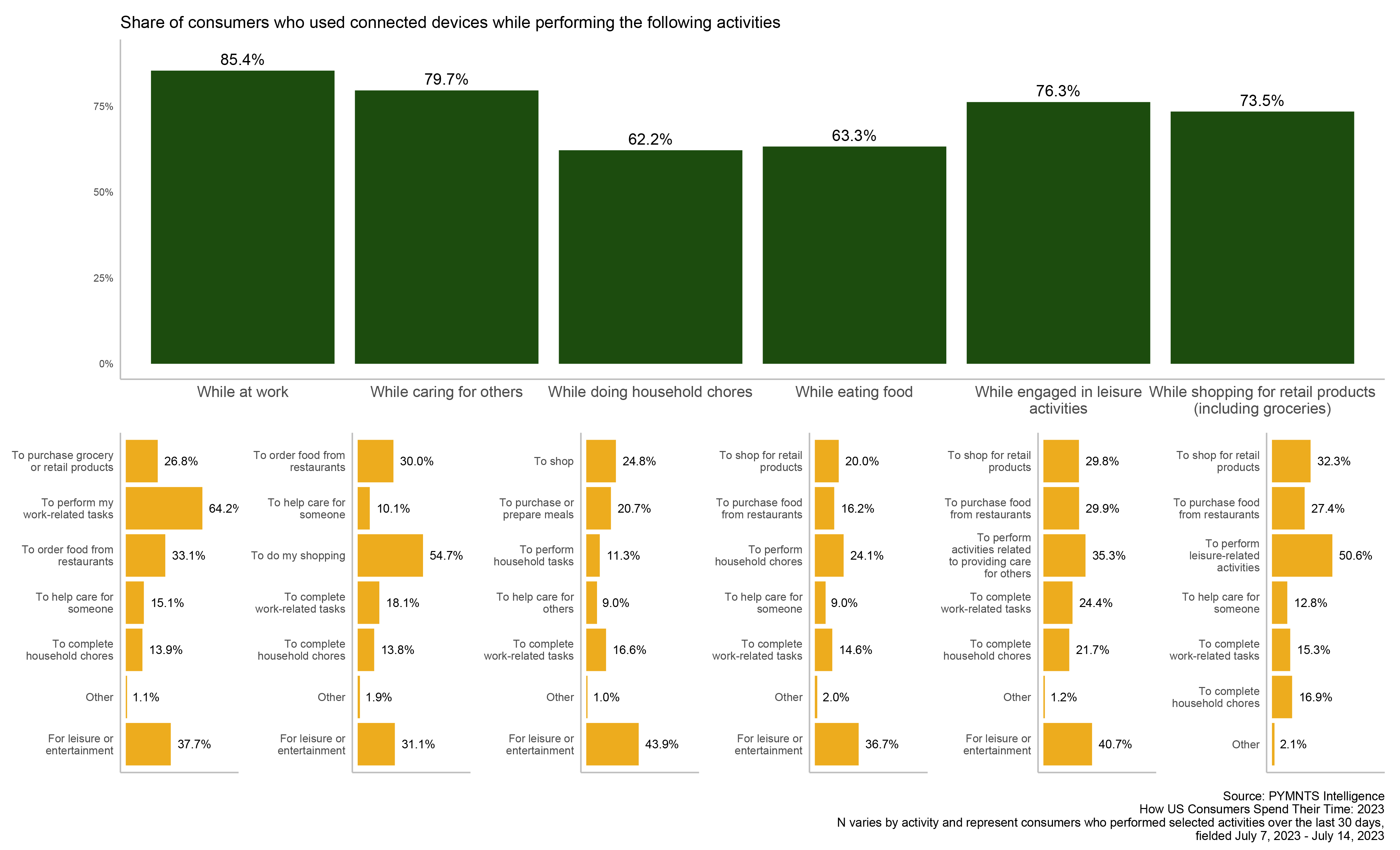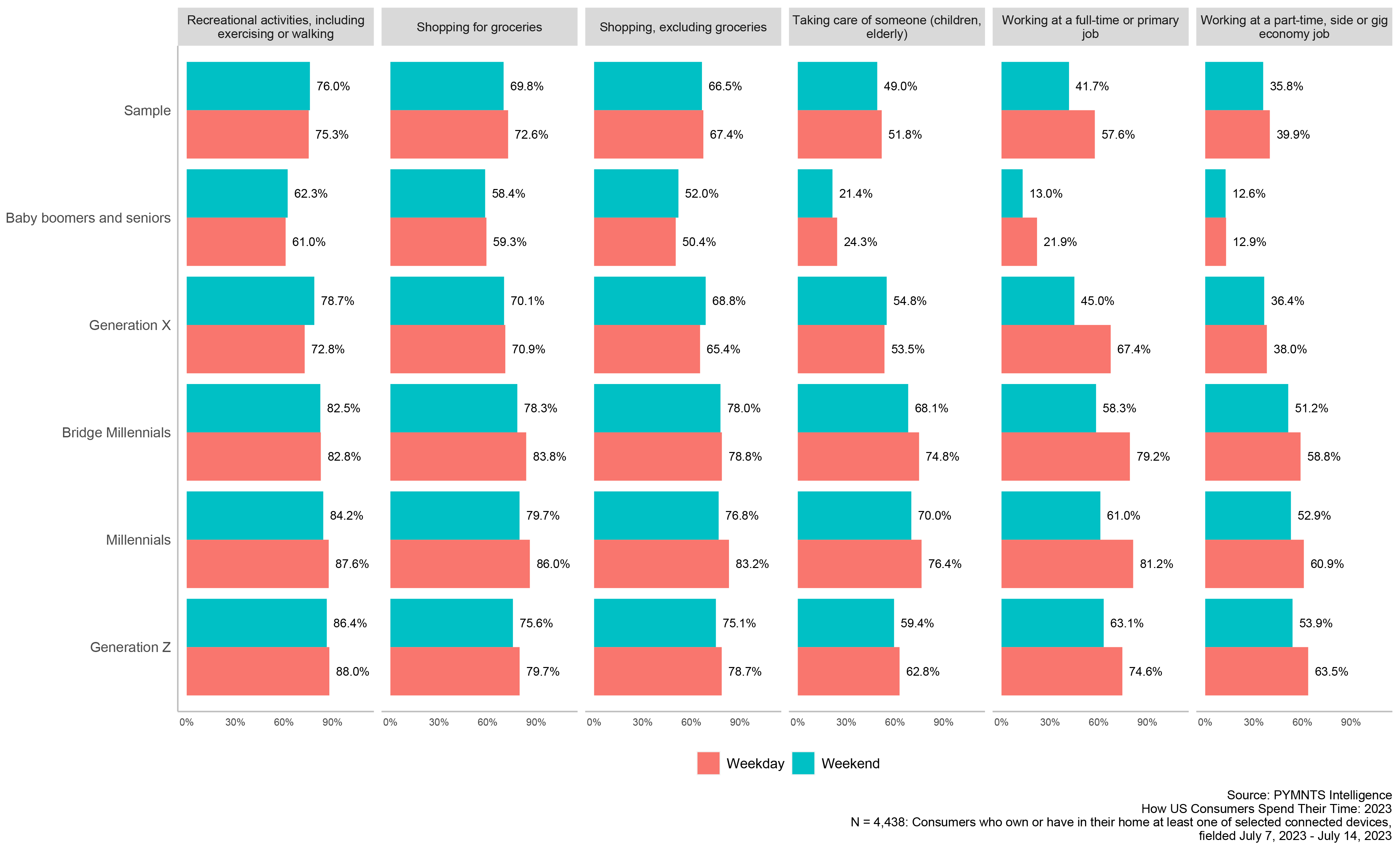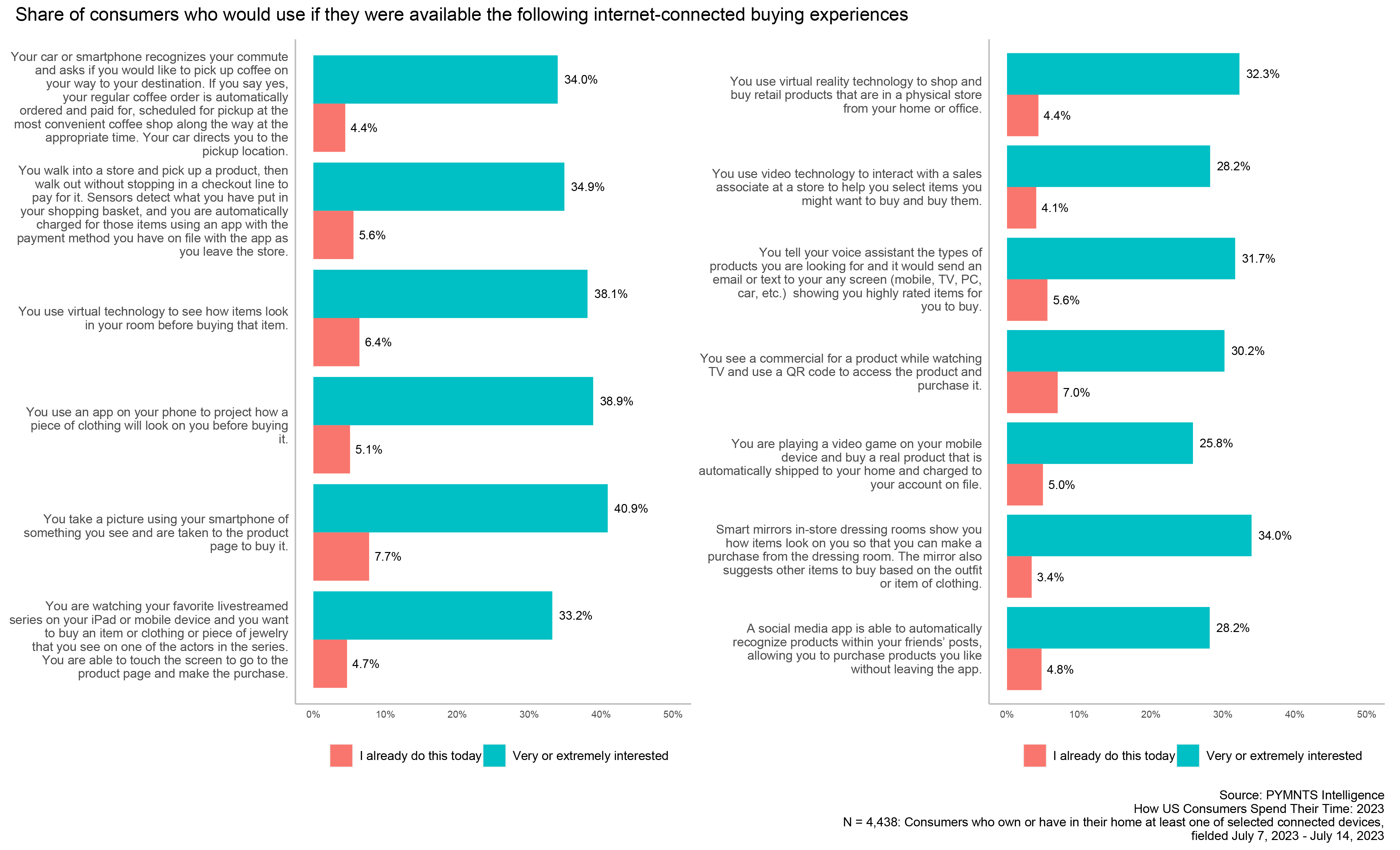Many of you may be reading this article on your smartphone or tablet while sitting in the back of an Uber on the way to the airport, at your desk in the office in between meetings or at the kitchen counter eating breakfast or lunch — even with CNBC or Bloomberg playing on the TV in the background.
Reading it might have reminded you that you need to order groceries for dinner tonight, which you swiped off to do. Thinking of food reminds you to make a dinner reservation for Friday night because friends are coming into town for the weekend. This is all done without keeping you from your next meeting or Zoom call, your trip to the airport, finishing your egg and cheese sandwich — or even reading this article.
According to a new national PYMNTS study of 4,679 consumers between July 9 and 14, 2023, Americans spend about 26% of their time, on average, using smartphones and apps to multitask while doing another primary activity, regardless of whether they do so on a weekday or a weekend. Consumers who care for someone else — a child or a parent, for example — spend about 30 percent of their time doing something else using an app and a connected device. And Americans also spend about 25 percent of their work time multitasking.
Though employers, parents, partners, and friends might call this an unwelcome distraction, these connected multitaskers see a better way to make the best use of the finite 24 hours in a day that they get to spend.
The idea for conducting this PYMNTS research came from looking, year after year, at the results of The American Time Use Study. This government initiative, conducted by Census, documents how people spend 24 hours in their day by calling people and walking them through a 15-minute survey asking about their previous day’s activities.
[Just curious – has anyone out there reading this ever been called?]
Advertisement: Scroll to Continue
The Census groups these survey results into big buckets — how much time U.S. consumers spend reading, working, eating, shopping, cleaning, watching TV, etc.
You won’t be surprised to learn that since the study began in 2003, there has been an unremarkable shift in how people say they spend 24 hours in their day — a few small shifts here and there in how much time people spend reading or working or sleeping or watching TV.
What we now understand is just asking someone how they spend big chunks of their time minimizes the impact that connected devices and apps have on how consumers really use their time.
In truth, nearly everyone has mastered the art of multitasking — using digital devices and apps to economize on their time.
How Consumers Really Spend Their Time
Multitasking isn’t new — consumers have been listening to the radio while driving in the car, reading the newspaper while watching TV and listening to music while cleaning for decades. The difference in a modern, digital world is how consumers can use connected devices and apps to do the things that once required going to a physical place at the same time they are doing something else in the physical world.
It’s not just Gen Z and Millennials who are using their connected devices, and mostly their smartphones, to do more than one thing at a time.
According to this PYMNTS study, 95% of the U.S. population has access to a connected device, mostly a smartphone, and uses it to conduct everyday activities while doing something else. Overall, the ability to conduct simple digital tasks like texting someone while eating a meal or adding items to a shopping list using a voice-activated speaker while cooking or cleaning the kitchen is largely universal — how often it’s done and what devices are used is more related to a person’s lifestyle than their interest in or capability to perform that activity.

We observe that while consumers use digital channels most often to complement their primary activity — working while at work, shopping while at a store — they also engage in five other non-related activities to some degree while doing so: streaming music (hopefully not movies) while working, ordering food while shopping, doing household chores while caring for someone else. More than half of consumers (52%) used a connected device while eating breakfast. Among consumers that commuted to or from work on a weekday, 69% of them used a connected device while doing so to get directions, order at QSR drive-thru or pay for parking.
Most consumers say they use their smartphones to engage in work-related activities while doing most every other activity, including 15 percent who say they check on work during their leisure time.
A new generation of more technologically advanced connected devices and emerging technologies like Generative AI will make this connected multitasking an embedded part of the consumer’s daily routine: more integrated, easier, smarter, and more personalized.
Cars that automatically activate gas pumps and make purchases to a registered credential without a swipe today will activate commerce experiences in the car while commuting to the office or taking the kids to football practice. Miniaturized medical devices will monitor a person’s vital signs as they go about their daily routine and automatically record that data into their electronic medical record for their doctor to see 24 hours a day to act on as needed. Voice-powered AI operating systems will take the connected multitasking concept to a whole new level, creating an always-on ambient environment where tasks are but a spoken word away — anywhere a consumer may happen to be in the physical world.
Time Saving and Saving Time
The fact that people have been using connected devices and apps to blur the digital and physical worlds isn’t news; I’ve been writing about it since Uber introduced the app that made it possible for a physical world experience to be activated using a smartphone in 2009. But over the last 14 years, we’ve seen those lines disappear and shift how consumers use their time in meaningful ways.
For a connected American consumer in 2023, weekends and weekdays now look the same as apps and smartphones break down the constraints once imposed by the physical world.
According to PYMNTS research, as many consumers now say they shop for groceries on weekdays as on the weekend, with millennials favoring weekdays to weekends — and online options influencing those behaviors.

Trips to the physical grocery store no longer have to be a perfunctory Saturday chore with kids in tow. Apps and aggregators and saved shopping lists make it easy for consumers to have groceries delivered on a Thursday afternoon or arranged for pickup curbside on a Wednesday evening on the way home from work — and purchased while streaming a favorite movie, waiting in the doctor’s office for an appointment, or on the airplane home before takeoff. Buying clothes and sporting goods follows the same pattern, with connected devices and apps giving consumers more choices about how to spend their time.
The appetite for accessing these connected experiences that few consumers thought even possible five years ago is only increasing as apps get better, smartphone cameras improve and innovators create new ways to embed new experiences into an expanding variety of apps and connected devices that save consumers time and money.

Connected devices and apps have not only given consumers the tools to multitask, but they have also provided innovators the inspiration to think creatively about using them to save time and reduce friction. More than a third of U.S. consumers are now interested in apps that help them see how clothes fit or how furniture looks in a room before making a purchase or taking a picture of an item and be immediately directed to a product page where it can be bought. Each of those activities, thanks to a smartphone or other connected device, saves time — and can be done while doing other things. More than that, using them also reduces the risk that an item a consumer sees online and loves could instead become a friction-filled return experience that takes up her time.
The Durability of the Digital Shift
Three years post-pandemic, questions remain about the durability of the digital shift and whether digital’s appeal will wane as consumers quench their thirst for the physical experiences they missed during COVID.
We find the shift to be durable, especially as consumers rethink how they want to spend their time.
We see it in how consumers shop for the one thing that they almost always used to do in a physical store: buy groceries. During the pandemic, many more people shopped online for groceries (from 9% in 2019 to 30% in 2020) and although many of those consumers have returned to the physical store, more than twice as many consumers shop online for groceries in 2023 (19%) as did before the pandemic. That same trend holds for retail shopping as well.
More than just digital-first aficionados, consumers have become connected multitaskers over the last three years, emphasizing the extraordinary advances that digital and connected devices have made in how consumers can spend their time. For most consumers, the distinction between the physical and digital worlds is not becoming irrelevant — it is just a distinction without a difference.

That’s a wake-up call for the businesses that continue to minimize the importance of embedding digital into their experience as consumers return to the physical world. They’ve lost sight of the fact that consumers have always lived in the physical world — connected devices and apps have now changed how consumers want to engage within it.
For consumers, digital is no longer a channel.
And for the growing numbers of connected multitaskers, digital and connected devices give them the power to do more with the one thing they can’t replace once it’s gone: their time.








